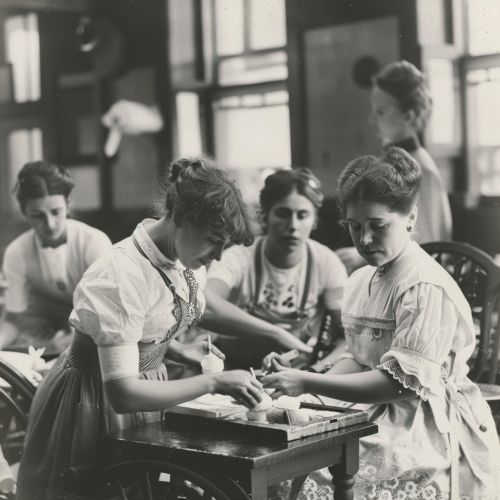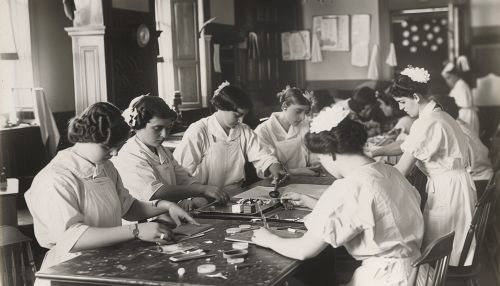Occupational Therapy
Definition and Overview
Occupational therapy (OT) is a branch of healthcare that focuses on helping individuals of all ages to perform everyday tasks and activities, which may be compromised due to physical, mental, or cognitive impairments. The primary goal of occupational therapy is to enable people to participate in the activities of everyday life. This is achieved by working with people and communities to enhance their ability to engage in the occupations they want to, need to, or are expected to do, or by modifying the occupation or the environment to better support their occupational engagement.
History
The roots of occupational therapy can be traced back to the 18th and 19th centuries when the moral treatment movement advocated for the humane treatment of people with mental illness. However, the profession of occupational therapy formally began in the early 20th century in response to the need for rehabilitation services for veterans returning from World War I. The term "occupational therapy" was coined by Dr. William Rush Dunton Jr., often considered one of the founding fathers of occupational therapy.


Theoretical Frameworks
Occupational therapists use various theoretical frameworks to guide their practice. These frameworks, often based on established models of human occupation, provide a structured approach to understanding and addressing the challenges faced by individuals in performing their daily activities.
Model of Human Occupation (MOHO)
The Model of Human Occupation (MOHO) is one of the most widely used frameworks in occupational therapy. Developed by Gary Kielhofner, MOHO views humans as being made up of three interrelated components: volition, habituation, and performance capacity.
Person-Environment-Occupation Model (PEO)
The Person-Environment-Occupation Model (PEO) is another key framework used in occupational therapy. It emphasizes the importance of the interaction between the person, their environment, and their occupation in determining their occupational performance.
Canadian Model of Occupational Performance and Engagement (CMOP-E)
The Canadian Model of Occupational Performance and Engagement (CMOP-E) is a client-centered framework that views occupation in terms of self-care, productivity, and leisure.
Practice Areas
Occupational therapists work in a wide range of practice areas, including but not limited to:
Physical Rehabilitation
In physical rehabilitation, occupational therapists help individuals regain or improve their physical abilities to perform daily activities. This may involve teaching alternative techniques, prescribing assistive devices, or modifying the environment.
Mental Health
Occupational therapists play a crucial role in mental health settings, helping individuals to engage in meaningful occupations to promote mental well-being.
Pediatrics
In pediatrics, occupational therapists work with children and their families to help them participate in daily activities such as play, school, and self-care.
Geriatrics
In geriatrics, occupational therapists work with older adults to help them maintain their independence and quality of life.
Assessment and Intervention
The process of occupational therapy typically begins with an assessment, during which the occupational therapist evaluates the individual's abilities, challenges, goals, and environmental factors. Based on the assessment, the occupational therapist then develops an intervention plan tailored to the individual's needs and goals.
Interventions may include:
- Therapeutic activities: These are activities designed to improve specific skills or abilities. For example, an occupational therapist might use a cooking activity to help a client improve their fine motor skills, planning abilities, and sequencing skills.
- Education and training: Occupational therapists often provide education and training to clients and their families. This might include teaching a client how to use an assistive device or educating a family on how to modify their home environment to support the client's needs.
- Environmental modifications: Occupational therapists may recommend changes to the client's environment to make it more conducive to their occupational performance. This could involve suggesting specific assistive devices or recommending changes to the layout of the client's home.
- Advocacy: Occupational therapists often advocate for their clients, helping them to access needed services or accommodations.
Education and Training
To become an occupational therapist, one must complete a master's or doctoral degree in occupational therapy. The educational program includes both classroom instruction and fieldwork experiences, providing students with the knowledge and skills needed to practice as an occupational therapist.
Following graduation, occupational therapists must pass a national certification exam to become licensed to practice. They must also complete continuing education requirements to maintain their licensure.
Future Directions
The field of occupational therapy continues to evolve in response to societal needs and advances in research and technology. Emerging areas of practice include community health and wellness, assistive technology, and telehealth services.
See Also
Categories
References
1. American Occupational Therapy Association. (2017). Occupational therapy practice framework: Domain and process (3rd ed.). American Journal of Occupational Therapy, 68(Suppl. 1), S1–S48. doi:10.5014/ajot.2014.682006 2. Kielhofner, G. (2008). Model of Human Occupation: Theory and Application. Lippincott Williams & Wilkins. 3. Law, M., Cooper, B., Strong, S., Stewart, D., Rigby, P., & Letts, L. (1996). The Person-Environment-Occupation Model: A transactive approach to occupational performance. Canadian Journal of Occupational Therapy, 63(1), 9-23. 4. Polatajko, H. J., Townsend, E. A., & Craik, J. (2007). Canadian Model of Occupational Performance and Engagement (CMOP-E). In Enabling Occupation II: Advancing an Occupational Therapy Vision of Health, Well-being, & Justice through Occupation. CAOT Publications ACE. 5. World Federation of Occupational Therapists. (2012). Definition of Occupational Therapy. Retrieved from https://www.wfot.org/resources/occupational-therapy-definition
